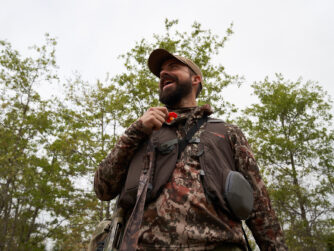Turkey calling is both an art and a science. And it ain’t for everyone. Nobody knows that more than Aaron Warbritton from The Hunting Public.
The Unique Fraternity of Turkey Hunters
Turkey hunting is a pursuit unlike any other, and calling is at the heart of the experience. Unlike whitetail hunters who sit in trees in silence, turkey hunters actively engage in a conversation. Warbritton says that turkey calling is a rare skill—one that can seem odd to those unfamiliar with the sport.
The ability to mimic turkey vocalizations can make the difference, but there’s no single approach to calling. Some hunters call frequently and aggressively, while others take a more reserved, patient approach. The key is knowing when to call and understanding the turkey’s response. You have to learn to speak the language.
Understanding Turkey Vocalizations
Turkeys produce a wide range of sounds, each with a specific purpose. Some of the most essential calls include:
- Tree Yelp: A soft, subtle call turkeys make when waking up on the roost.
- Plain Yelp: A foundational call used by hens to communicate with gobblers.
- Cluck: A short, non-threatening sound often used to locate other turkeys.
- Purr: A soft, rolling sound turkeys make when content or feeding.
- Cutting: A series of sharp, excited clucks that signal aggression or excitement.
- Fly Down Cackle: A rapid sequence of sounds turkeys make when leaving the roost.
Each of these sounds has a place in a hunter’s calling strategy. Warbritton says that listening to real wild turkeys is crucial for learning how to produce authentic calls. He recommends practicing by listening to turkey sounds on resources like the National Wild Turkey Federation’s (NWTF) website and trying to replicate them.
Calling Strategies: Aggressive vs. Patient Approaches
One of the biggest debates among turkey hunters is how much to call. Some hunters believe in frequent, aggressive calling to provoke a gobbler into responding, while others prefer to call sparingly and let the turkey make the next move. Warbritton explains that a hunter’s calling style often reflects their personality. Those who are more restless and active tend to call more often, while patient hunters are more selective in their calling.
The right approach depends on the turkey’s behavior. If a gobbler is actively responding, it may be best to call frequently and match his excitement. However, if a turkey is hesitant, backing off and calling less can sometimes be more effective.
The Importance of Cadence and Tone
While mastering the basic sounds is important, understanding cadence and tone is what separates great callers from average ones. Warbritton explains that turkeys don’t call with perfect, even rhythms. Instead, their calls have natural variations in pitch, tone, and speed. Mimicking this natural variation makes a caller sound more authentic and increases the chances of fooling a wary gobbler.
One of the most overlooked aspects of calling is pitch. Warbritton believes that different turkeys respond to different pitches. A hunter might call to a gobbler for an hour with no response, only to switch to a different call—such as a box call instead of a mouth call—and suddenly get a reaction. This is why experienced hunters carry multiple calls and experiment with different sounds.
Reading the Turkey’s Response
Understanding how a turkey responds to calling is critical. Warbritton shares an example of a hunt where a gobbler refused to respond to traditional calls but was eventually lured in by a real hen’s simple three-note yelp. This illustrates that sometimes less is more and that turkeys recognize and respond to familiar vocalizations from their environment.
Turkeys also have individual personalities and changing moods. A gobbler might be aggressive and eager to respond one day but completely silent the next. Hunters should be adaptable and adjust their calling strategy based on the turkey’s behavior.
Locating and Working Gobblers
When moving through the woods, hunters often use loud calls like cutting or a box call to locate turkeys from a distance. Warbritton explains that these calls can carry long distances, especially in open terrain. However, once a gobbler has been located and starts approaching, it’s usually best to switch to softer, more subtle calls like purring and clucking to seal the deal.
Another common mistake is moving too quickly after calling. Turkeys don’t always respond immediately. Sometimes a gobbler needs to hear a call multiple times before deciding to investigate. Warbritton advises hunters to give turkeys time to react rather than assuming no response means there’s no turkey nearby.
The Fly Down Sequence and Roosted Birds
One of the most exciting parts of turkey hunting is working birds off the roost. Many hunters use a fly down cackle combined with flapping a turkey wing to mimic the sound of a hen hitting the ground. While this can be effective, Warbritton warns that it’s also easy to mess up. If done incorrectly, it can alert the gobbler that something is off and cause him to move away.
In many cases, Warbritton prefers to remain silent until the turkey flies down. Calling too early can cause the gobbler to stay on the roost longer, waiting for the hen to come to him. Instead, waiting until the bird is on the ground and then calling can be a more reliable strategy.
Putting it All Together
Turkey calling is a skill that takes years to master, but every hunter can improve with practice and patience. Warbritton’s advice to new hunters is simple: don’t be afraid to make mistakes, listen to real turkeys as much as possible, and experiment with different calls to find what works best in different situations.






